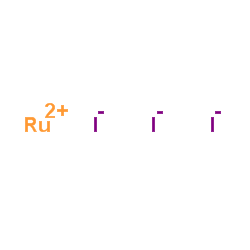RUTHENIUM TETROXIDE
Modify Date: 2025-08-21 20:05:05

RUTHENIUM TETROXIDE structure
|
Common Name | RUTHENIUM TETROXIDE | ||
|---|---|---|---|---|
| CAS Number | 20427-56-9 | Molecular Weight | 165.06800 | |
| Density | 3.290 | Boiling Point | 40ºC (other sources give 108ºC; presumably40ºC is at reduced pressure) | |
| Molecular Formula | O4Ru | Melting Point | 25.4ºC | |
| MSDS | N/A | Flash Point | N/A | |
| Name | tetraoxoruthenium |
|---|---|
| Synonym | More Synonyms |
| Density | 3.290 |
|---|---|
| Boiling Point | 40ºC (other sources give 108ºC; presumably40ºC is at reduced pressure) |
| Melting Point | 25.4ºC |
| Molecular Formula | O4Ru |
| Molecular Weight | 165.06800 |
| Exact Mass | 165.88400 |
| PSA | 68.28000 |
| Appearance of Characters | Crystalline Powder | White |
| Storage condition | Refrigerator (+4°C) |
| Stability | Stable. |
| Water Solubility | 2.03g/100mL H2O (20°C); very soluble CCl4, other chlorinated hydrocarbons [MER06] [KIR82] |
|
Section 1: Product Identification Chemical Name:Ruthenium(VIII) oxide (0.5% stabilized aqueous solution) CAS Registry Number:20427-56-9 Formula:RuO4 EINECS Number:none Chemical Family:metal oxide Synonym:ruthenium tetroxide
Section 2: Composition and Information on Ingredients IngredientCAS NumberPercentACGIH (TWA)OSHA (PEL) Title Compound20427-56-90.5%no datano data Section 3: Hazards Identification Emergency Overview:Irritating to skin, eyes and mucous membranes. May be harmful if swallowed. Primary Routes of Exposure:Ingestion, eyes Eye Contact:Causes slight to mild irritation of the eyes. Skin Contact:Causes slight to mild irritation of the skin. Inhalation:Irritating to the nose, mucous membranes and respiratory tract. Ingestion:No specific information is available on the physiological effects of ingestion. Acute Health Affects:Irritating to skin, eyes and respiratory tract. Chronic Health Affects:Exposure to ruthenium tetroxide dust and vapors may cause severe permanent damage to eyes and lungs. NTP:No IARC:No OSHA:No SECTION 4: First Aid Measures Immediately flush the eyes with copious amounts of water for at least 10-15 minutes. A victim may need Eye Exposure: assistance in keeping their eye lids open. Get immediate medical attention. Wash the affected area with water. Remove contaminated clothes if necessary. Seek medical assistance if Skin Exposure: irritation persists. Remove the victim to fresh air. Closely monitor the victim for signs of respiratory problems, such as difficulty Inhalation: in breathing, coughing, wheezing, or pain. In such cases seek immediate medical assistance. Seek medical attention immediately. Keep the victim calm. Give the victim water (only if conscious). Induce Ingestion: vomiting only if directed by medical personnel. SECTION 5: Fire Fighting Measures Flash Point:not applicable Autoignition Temperature:not applicable Explosion Limits:not applicable Extinguishing Medium:Aqueous solution - non-flammable When dry acts as an oxidizer towards organics. Smothering the fire may not be effective. A NIOSH approved Special Fire Fighting Procedures: self contained breathing apparatus should be worn. Hazardous Combustion andToxic ruthenium tetroxide could be present in gasses. Decomposion Products: Wetting the dried solid with small amounts of alcohols, solvents or combustible powders may lead to ignition Unusual Fire or Explosion Hazards: and fire. SECTION 6: Accidental Release Measures Small spills should be flushed with sodium bisulfite solution to detoxify ruthenium tetroxide, and then be mixed Spill and Leak Procedures: with vermiculite or sodium carbonate and swept up. Do not mix with combustible materials. SECTION 7: Handling and Storage Handling and Storage:Store in a cool dark place in tightly closed containers. SECTION 8: Exposure Controls and Personal Protection Eye Protection:Always wear approved safety glasses when handling a chemical substance in the laboratory. Skin Protection:Wear appropriate chemical resistant gloves and protective clothing. Ventilation:Material may form a fine dust or vapor. If possible, handle the material in an efficient fume hood. If ventilation is not available a respirator should be worn. The use of respirators requires a Respirator Respirator: Protection Program to be in compliance with 29 CFR 1910.134. Ventilation:Material may form a fine dust or vapor. If possible, handle the material in an efficient fume hood. Additional Protection:No additional protection required. SECTION 9: Physical and Chemical Properties Color and Form:yellow liq. Molecular Weight:165.7 Melting Point:no data Boiling Point:(water) Vapor Pressure:no data Specific Gravity:no data Odor:acrid odor Solubility in Water:material is a water solution SECTION 10: Stability and Reactivity Stability:heat sensitive, (store cold, in the dark) Hazardous Polymerization:no hazardous polymerization Conditions to Avoid:The dry powder reacts violently with paper, alcohol, and other combustibles. Incompatibility:Reducing agents, organic materials, active metals and halogens Decomposition Products:ruthenium and oxygen SECTION 11: Toxicological Information RTECS Data:No information available in the RTECS files. Carcinogenic Effects:No data available Mutagenic Effects:No data available Tetratogenic Effects:No data available SECTION 12: Ecological Information Ecological Information:No information available SECTION 13: Disposal Considerations Disposal:Dispose of according to local, state and federal regulations. SECTION 14: Transportation Shipping Name (CFR):Oxidizing liquid, N.O.S. Hazard Class (CFR):5.1 Additional Hazard Class (CFR):NA Packaging Group (CFR):II UN ID Number (CFR):UN# 3139 Shipping Name (IATA):Oxidizing liquid, N.O.S. Hazard Class (IATA):5.1 Additional Hazard Class (IATA):NA Packaging Group (IATA):II UN ID Number (IATA):UN# 3139 SECTION 15: Regulatory Information TSCA:Not listed in the TSCA inventory. SARA (Title 313):Title compound not listed. Second Ingredient:none SECTION 16 - ADDITIONAL INFORMATION N/A |
| Safety Phrases | S16-S17-S36-S37-S39 |
|---|---|
| RIDADR | UN 3139 |
| Packaging Group | I |
| Hazard Class | 5.1 |
| HS Code | 28439000 |
| Precursor 7 | |
|---|---|
| DownStream 4 | |
| EINECS 243-813-8 |
| Ruthenium(VIII) oxide |
| ruthenium oxide |
| ruthenium tetraoxide |
| Ruthenium tetroxide |
 CAS#:7440-18-8
CAS#:7440-18-8 CAS#:7722-64-7
CAS#:7722-64-7 CAS#:14380-61-1
CAS#:14380-61-1 CAS#:14521-18-7
CAS#:14521-18-7 CAS#:25604-36-8
CAS#:25604-36-8 CAS#:67251-55-2
CAS#:67251-55-2 CAS#:80937-33-3
CAS#:80937-33-3 CAS#:14014-88-1
CAS#:14014-88-1 CAS#:10049-08-8
CAS#:10049-08-8 CAS#:13896-65-6
CAS#:13896-65-6